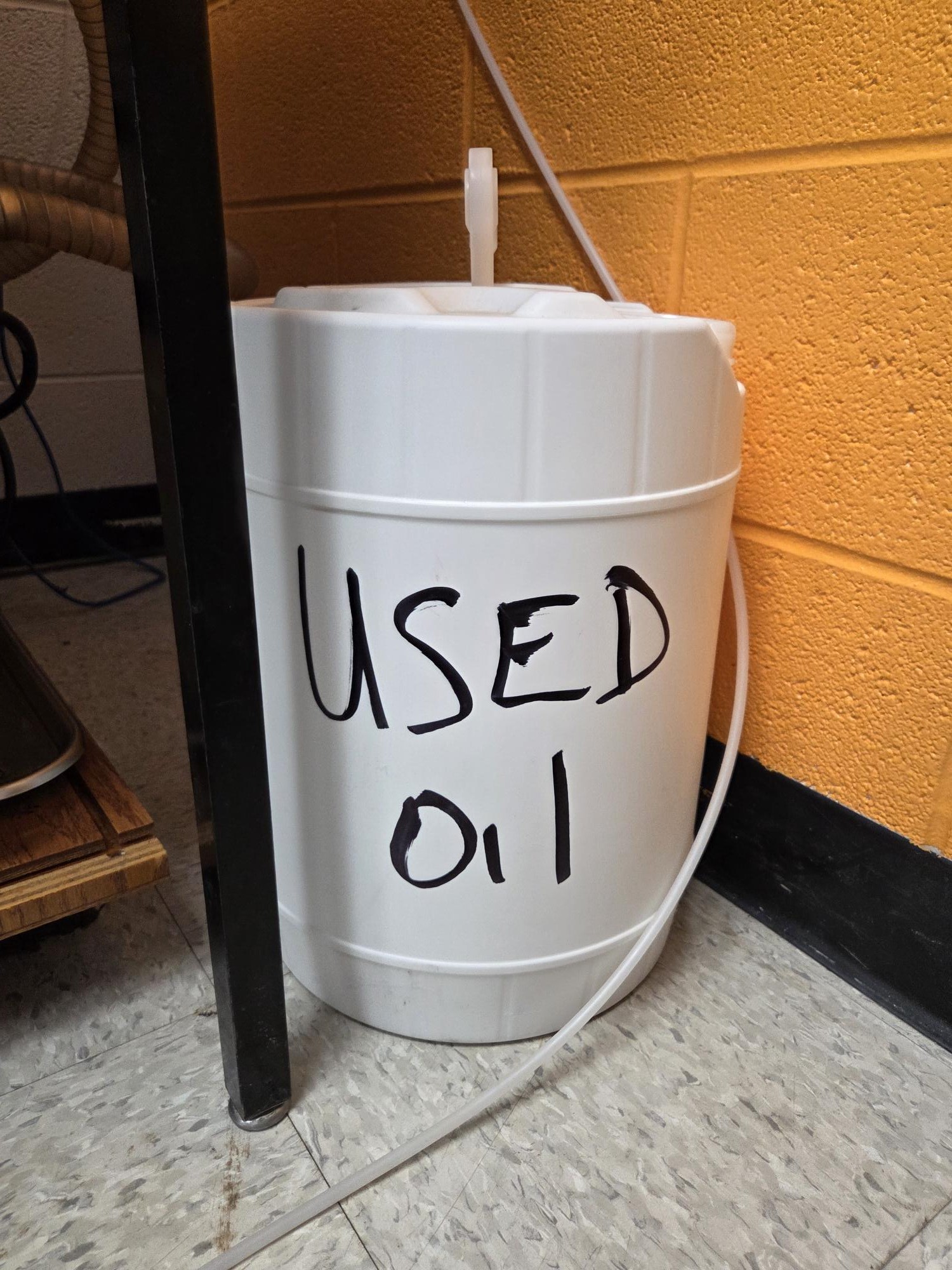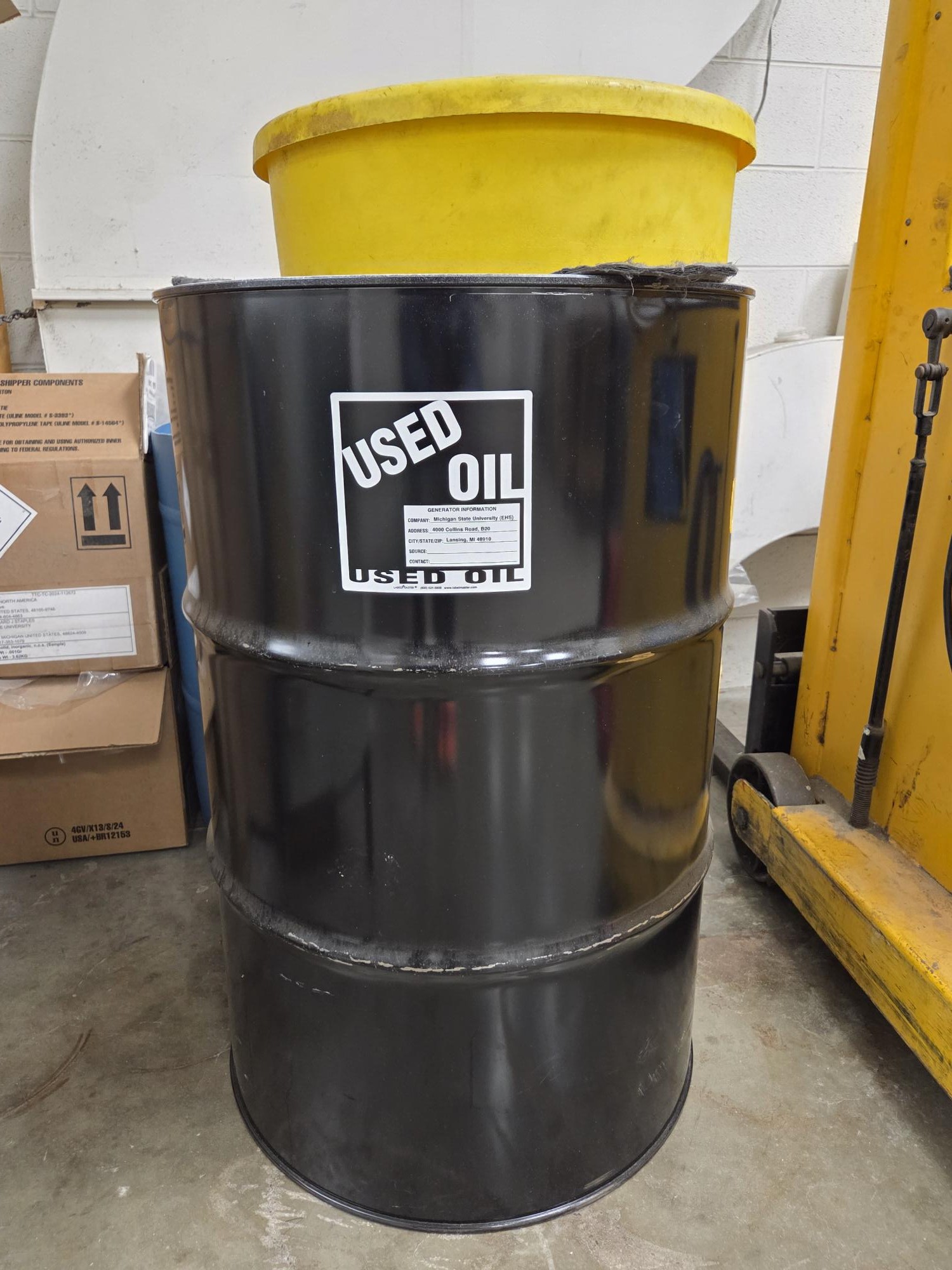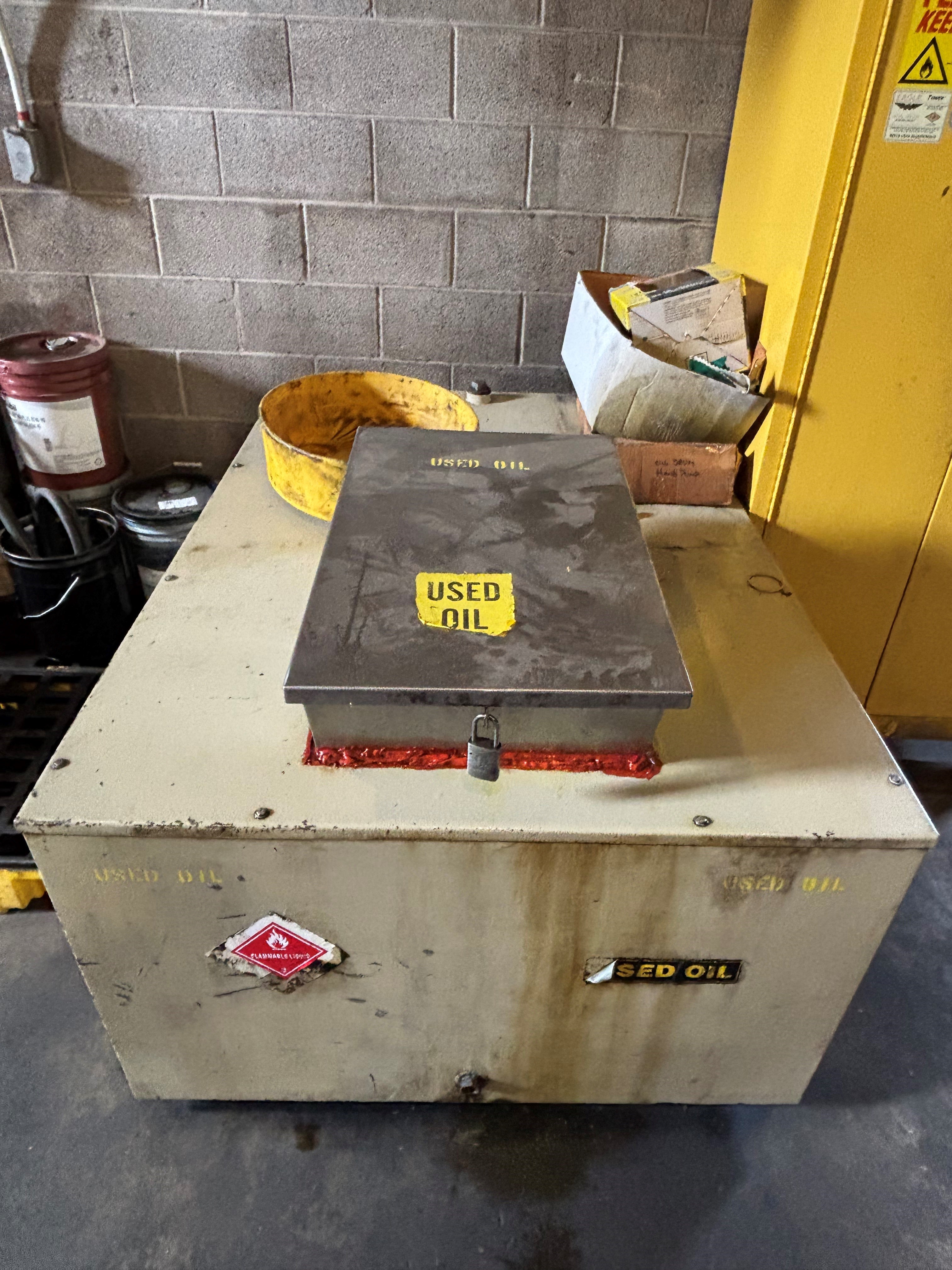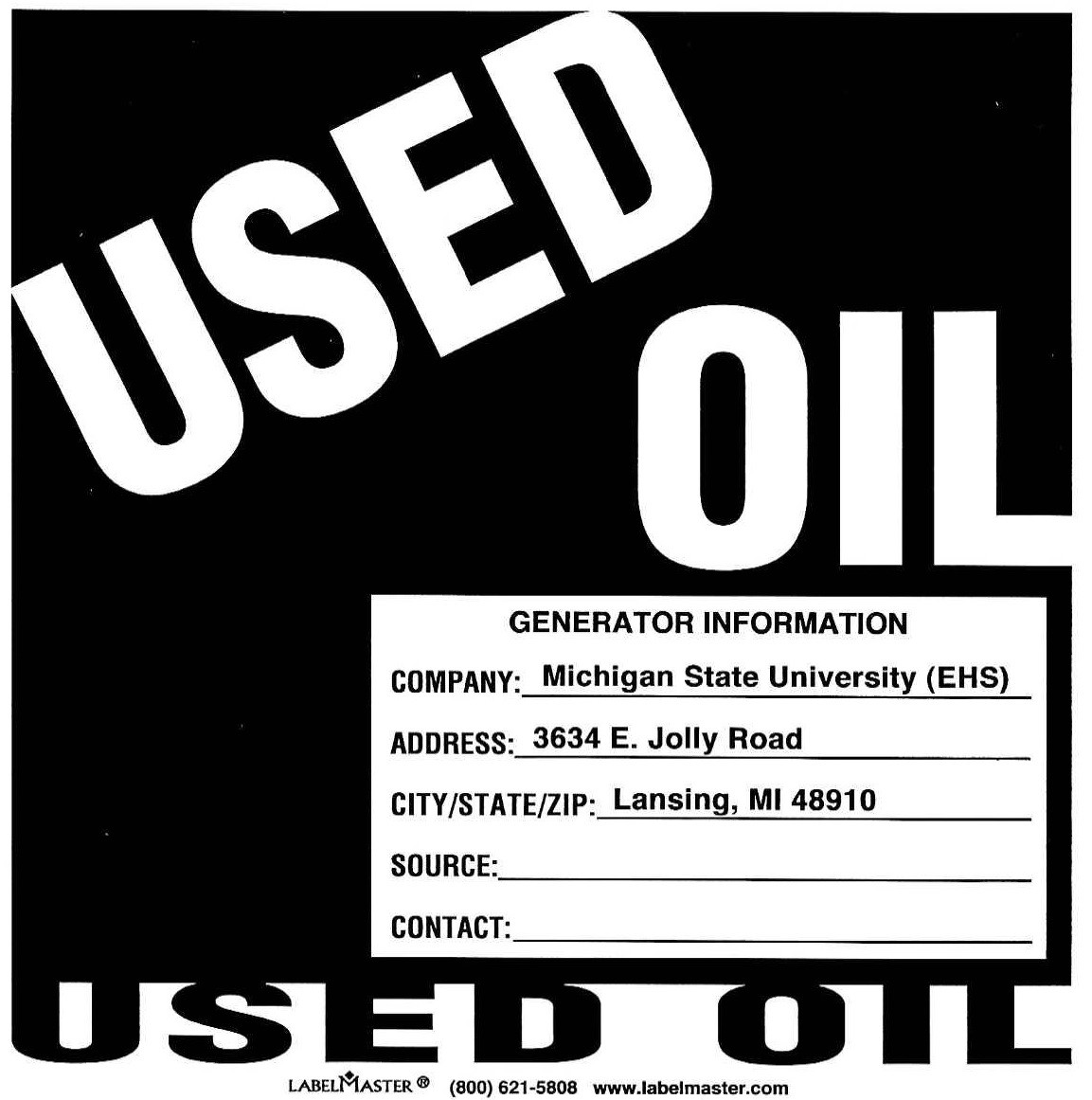Used Oil
Definition
Used oil is defined as any oil that has been refined from crude oil, or any synthetic oil which has been used and is now contaminated with physical or chemical impurities. Used oil is generated in many aspects of research and operational activities at MSU and must be disposed of through the EHS Hazardous Waste Program. In liquid form, used oil cannot be disposed of down any drain (sanitary or storm), in a landfill, or used as weed or dust control.
Examples of used oil may include motor vehicle oil, hydraulic oil, transmission or brake fluid, cutting and machine oils, pump oil, non-polychlorinated biphenyl (PCB) transformer oil, and chlorofluorocarbon (CFC) contaminated oil, or any oil and water mixtures of these materials.
Although not included under the used oil regulations, vegetable oil and animal fat oils can also be given to EHS for disposal and should not go in the general refuse trash or down the drain.
Used Oil waste should never be mixed with any of the following:
- Hazardous Waste
- Vegetable and animal fat oils
- Refrigeration system oil which may contain CFCs
- Immersion oil which may contain PCBs
Container Type
If disposing of unwanted oil in the original manufacturer’s bottles with an intact label, the materials can be given directly to the EHS Hazardous Waste Program for disposal and should not be transferred into another container.
When reusing empty containers, they must be compatible with the type of chemical waste stored in them. Empty reagent bottles can be used for chemical waste collection after following the Empty Bottle guidance in the Waste Section of the EHS website.
Liquid Containers <50-gallons in Size
Although EHS does not maintain a list of compatible materials, in general used oil can be stored in glass and plastic containers. However, do not store liquid waste in containers that previously held solids, as they will leak. Container compatibility information is also available on Safety Data Sheets. EHS provides 5-gallon high density polyethylene (HDPE) carboys for liquid waste storage, which are proven to be compatible with a variety of waste types.
Liquid Containers >50-gallons in Size
For MSU locations that generate larger quantities of used oil, it can also be stored in approved tanks, and 55-gallon drums. EHS can provide 55-gallon HDPE drums for used oil storage.
Any permanent used oil storage tanks must be inspected regularly by EHS. Contact the EHS Environmental Group to make sure your tank is on their inspection list.
Spill Cleanup Debris
Solid material and PPE from small spills of used oil that occur indoors and have been contained with absorbent and exhibit no signs of free flowing liquid can be disposed of in a heavy duty plastic bag, sealed, and throw into the general refuse dumpster.
For larger spills of used oil, or those that occur outside, contact the EHS Environmental Group immediately for guidance.
Storage
Waste containers must be kept free of any liquids or residue on their exteriors. EHS Hazardous Waste Staff will reject any container with liquid or residue on the exterior until it has been cleaned. Leaking waste containers will not be accepted, and the contents must be transferred to a new container prior to disposal by the EHS Hazardous Waste group.
- All container lids MUST be closed tightly unless waste is being actively added to the container.
- Do not overfill containers.
- Secondary containment is not required but is recommended for waste storage.
- Do not accumulate more than 55-gallons total of hazardous waste in your location. This limit applies to the sum of full containers and partial containers being filled.
- Submit frequent requests for waste pick up through the EHS Hazardous Waste Request form to stay within the 90-Day storage limit and minimize the amount of waste containers in your space.
- Do not move hazardous waste from the location that it was generated.
MSU Waste Tag Required
Yes - A MSU Waste Tag is required for all waste not contained in a manufacturer’s bottle with an intact or legible label.
No - A MSU Waste Tag is not needed when submitting chemical reagents in the original manufacturer’s bottle with an intact label or when storing used oil in drums, totes, or tanks.
MSU Waste Tags must be directly affixed to the waste container either with string, a twist tie, chain and clipboard, rubber band, or tape. MSU Waste Tags are provided by EHS and can be requested through an EHS Hazardous Waste Request.
Labeling
Used Oil containers must be labeled “Used Oil” and contain the accumulation start date. . DO NOT label the container with the words “Hazardous Waste”, “Waste Oil”, or any other word combination. The accumulation start date is the first day that you begin filling the container with oil. Alternatively, EHS provides the following label for Used Oil, which can be requested through the EHS Safety Portal:
Submit Hazardous Waste Request
If utilizing a tank for storage, contact EHS when tank is ¾ full to schedule removal. For projects involving the disposal of transformer oil or other large amounts of oil, contact EHS prior to the start of the project to review vendor information and coordinate disposal to avoid unnecessary delays.
Shipping documents for any regulated waste, including used oil, should never be signed by any individual outside of the EHS Hazardous Waste Staff as most of these documents have a generator certification declaration that can result in fines or jailtime if the signee does not have the proper training documentation. including used oil shipments.
- EHS Website: ehs.msu.edu
- Log in to the Safety Portal through a preferred web browser using your MSU Net ID and EBS Password
- Select Hazardous Waste Request
- Used Oil is found under the Common Process category





